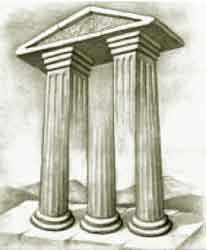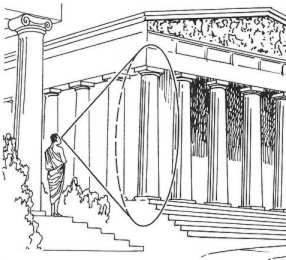Ancient Greece: OpticsMichael Lahanas Αρχαία Ελληνική Οπτική |
|
|
Optik im antiken Griechenland
Antisthenes: Plato, I see particular horses, but not horseness.
Plato: That is because you have eyes but no intelligence.

Are the columns rectangular? Are there two or three columns? © Sandro Del-Prete.
What is Optics?
The word comes from the Greek for eye, οψ , but the study of the eye itself is physiology and neurology, the study of vision a branch of psychophysics, and the study of illumination and color an applied field of its own. Optics is descended from the ancient Greek science of mathematical perspective, in which the behavior of the rays of vision was discussed by deductive geometry.
that allows us to “see” the invisible “forms”.
Philippus of Opus (Φίλιππος ο Οπούντιος) (4th century BC)
from Opus, or Medma in Locris, a disciple of Plato and a contemporary of Eudoxus. He is cited by Vitruvius, Stobaeus, Eudemus, Diogenes Laertius, Suidas and Stephen of Byzantium. He wrote many books but only fragments survived, among his books are:
Optics, 2 books
Enoptrics, 2 books
The rainbow as a phenomenon of diffraction
(Information from the Technology Museum of Thessaloniki)

The ancient Greeks studied the geometric properties of light. According to a optics text book they considered only rays inside the cone of visibility. Such light cones from an optical source in the study of sundials could probably also be the reason of the discovery of conic sections.
Aristophanes
Aristophanes in The clouds (420 BC) describes the light focus effect of a lens:
STREPSIADES Have you ever seen a beautiful, transparent stone at the druggists', with which you may kindle fire?
SOCRATES You mean a crystal lens.
STREPSIADES That's right. Well, now if I placed myself with this stone in the sun and a long way off from the clerk, while he was writing out the conviction, I could make all the wax, upon which the words were written, melt.
Archimedes (Αρχιμήδης ο Συρακούσιος)
He was involved in catoptrics (reflections from surfaces) and in refraction, but his writings in this field are lost. He is known from using burnig mirrors to set Roman ships in fire. with scenes of Archimedes burning mirrors
See also:
and
(c. 135-51 BC). His explanations remained at the geometrical level, and he did not speculate on sensory mechanisms, Helen E Ross, Perception 2000, volume 29, number 7, pages 863-871
The full moon rising in the east at sunset appears huge and close, especially over a flat horizon, as does the red setting sun in the west. At midnight, the moon sailing high seems small and distant. Of course, the size of the moon as measured by the angle subtended at the eye is the same in both cases (except as slightly modified by refraction). The difference is in the mental perception of size. This is possibly the most commonly recognized optical illusion, although it is different from the usual ones. It has received extensive study. Minnaert discusses it at length in The Nature of Light and Colour in the Open Air, pp. 155-166. The effect is most striking seen over flat land, such as the Flanders coast or the Llano Estacado of Texas, and is weaker over the sea or in the mountains...
The horizon illusion was known and remarked from antiquity. The rising moon seemed four times as large as the moon in the zenith. At first it seemed close, almost an earthly thing, but later its celestial nature took hold. Ptolemy explained that this was only apparent; the objective size of the moon was no different on the horizon than in the zenith. He said that although the celestial sphere was, indeed, a sphere, it appeared farther from the observer at the horizon, and bodies subtending the same angle appeared larger when presumed to be at a greater distance. A man at 1000 yards subtending the same angle as a man at 100 yards, would indeed appear to be a giant. It was the misjudgment of distance that caused the illusion. I feel that this explanation, though incomplete and unsatisfying, is still rather close to the best that can be said given our state of knowledge. There have been very many explanations and analyzes of the horizon illusion, many which accept Ptolemy's foundation, and seek to understand why distances to the horizon are misjudged, and others that look for some different cause. In fact, there is a book on the horizon illusion, and it has been the subject of more scientific papers than any other optical illusion. (J. B. Calvert)
)
A. Mark Smith The psychology of visual perception in Ptolemy's Optics. Isis. Jun;79(297):189-207. 1988
*A. Mark Smith: Ptolemy's Theory of Visual Perception, Transactions of the American Philosophical Society, Vol. 86, Part 2, 1996 p 101-102
Optical lenses
From the book "Ancient Inventions" by Peter James & Nick Thorpe, published by Ballantine Books in 1994
Two lenses of optical quality are on display at the Heraklion Museum of ancient Cretan civilization. As many as fifty were reported as having been found in the excavations of Troy, though only a handful have been properly published.
Some lenses from these sites have impressive magnifying powers. One lens, probably of the fifth century B.C., found in Crete, can magnify with perfect clarity up to seven times. If it is held farther away from the object viewed, it will actually magnify up to twenty times, though with considerable distortion.
COLORS
EXTRACT OF MR. DUTEN’S INQUIRY INTO THE ORIGIN OF THE DISCOVERIES ATTRIBUTED TO THE MODERNS
from